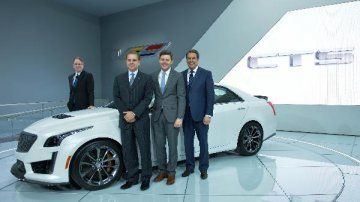
The world's largest car market is experiencing what some industry watchers say is its biggest slowdown in two decades. Foreign automakers, such as General Motors have so far been able to weather the storm, but others, such as Ford, have watched their business in the region deteriorate.
China is the world's largest car market, with about 28 million vehicles expected to sell in 2018, according to IHS Markit. That is compared with about 17 million expected in the U.S., the world's second largest car market.
Auto sales in China fell 14 percent in November over the same month in 2017, said the Chinese Association of Automobile Manufacturers. This has continued a general downward trend in the country that began in July, but the November declines are the worst so far this year.
The Chinese government has reportedly considered taking action to reverse course, and automakers are unrolling plans to revamp lineups and devote more attention to one of the last great growth opportunities in the world.
"This is the first sustained downturn in memory," said Michael Dunne, CEO of ZoZoGo, a firm that advises automakers on doing business in China. "We would have to go back to the Asian financial crisis in 1998-1999 to see the last time China had flat or down sales for four months or more in a row."
There are a few factors that have contributed to the slowdown in the region.
One is a crackdown this year by the Chinese government in certain unconventional forms of lending, Dunne said. For several years China permitted a form of peer-to-peer lending that allowed wealthier Chinese to lend money directly to the less wealthy, without going through a traditional banking system. This form of peer-to-peer lending has made a lot of credit available to newly minted members of China's growing middle class, particularly in second- and third-tier cities, which are so named for their smaller size and smaller economies when compared with first-tier cities such as Beijing and Shanghai. This has made this demographic one of the fastest growing markets in China's automotive industry.
But since the beginning of 2018, as many as 25 percent of the businesses facilitating this type of lending have been closed or shut down, Dunne said.
That has put the remaining three quarters on notice, and stoked fears they may be the next to come under scrutiny. Everyone in that business has grown a lot more careful and the cash flows that were formerly so available to this important segment of buyers have dried up.
There is some disagreement over just how influential peer-to-peer lending is in China as the auto market has matured.
"In the new-car market, P2P is a relatively small financing method," to Jacob George, who is vice president and general manager of J.D. Power Asia Pacific. "It is only about 2.7 percent of the retail credit market. Hence, we don't believe that this will have a major effect on the new-car market."
They were a more significant and growing source of funds in the used car market, until 2018, George said, but tighter regulations have likely shrunk the market.
The reason for the discrepancy could be that when consumers secure loans through informal or unlicensed channels, they either take the money to a dealership and pay cash for a vehicle, or take the money to a bank and secure a loan, Dunne said. Thus when surveyed, consumers might be saying they are using loans from banks rather than unlicensed channels.
An even more significant factor influencing the downturn has to do with the mindset of Chinese consumers, Dunne said. China's economy is showing signs of slowing, and the trade war with the United States is something virtually no one in that country has experienced before. This has produced a lot of uncertainty, which leads to a kind of bearishness among Chinese buyers that tends to be much stronger than what one might see in other cultures.
Some brands have fared better than others of course.
General Motors reported record equity income of $500 million in China in the third quarter of 2018, despite the challenging environment. The company is expecting to make $2 billion in the region for the whole of 2018. GM reports its income as "equity income" due to its arrangement with its joint venture partner Shanghai Automotive Industry Corporation. In China, all foreign automakers have to partner with local manufacturers.
On the one hand, GM has seen sales of some profitable vehicles rise. Sales at Cadillac, GM's luxury brand, rose 20 percent in the third quarter, with a strong mix of products.
Ford has also struggled because it has not introduced new products at a fast enough pace to keep up with changing demand and competition from the bevy of manufacturers operating in the country. But Ford has recently taken steps to address its less-than-stellar performance. The automaker has appointed a president and CEO just for China alone and separated Ford China from the rest of Ford's Asia-Pacific group. It is also introducing 50 new vehicles by 2025, some of which are directed right at that burgeoning middle class in China's second-tier cities.
Ford's sales in China are down more than 30 percent year-to-date compared with the same January-November period in 2017. In November, sales fell more than 50 percent over the same month last year. However, it is also important to note that Lincoln sales have fared better, taking advantage of the growing luxury market in the country. Lincoln sales were up 3 percent year-to-date in the country in November, with sales of flagship models such as the Navigator up 129 percent over the same month in 2017.
Despite the recent slowdown, there is still plenty of room left for growth in the country. By 2024, IHS expects China auto sales to hit around 33 million units.
Source: CNBC























Latest comments